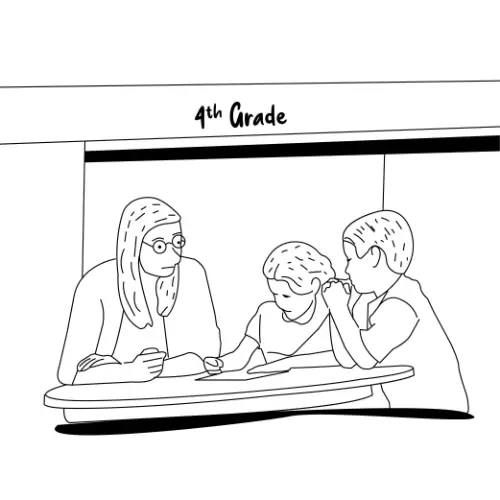As a teacher or homeschooler, you want what is best for your 4th-grade students, including their financial education. You may be preparing lesson plans right now to hit the points you want them to learn but feel a bit stuck as to which topics to focus on and reinforce. Fortunately, this guide for teaching money education to 4th-graders is here to help. Following the National Standards for Personal Financial Education, we will go through the most vital topics you should teach your upper elementary students: earning income, spending, saving, investing, managing credit, and managing risk. Additionally, we’ll give you pre-made, ready-to-go lesson plans that you can use anytime to deliver engaging instruction effortlessly.
National Standards for Personal Finance Education
Download Our Free Teachers' Cheat Sheet
Our free cheat sheet covers every learning objective in the National Standards for Personal Finance Education and the corresponding Kids' Money Lesson Plans - we cover each and every standard!
Earning Income
As your students progress through elementary school and become more independent, they will enjoy learning how to earn income. Teachers can emphasize the many available job paths based on people’s skills, experience, and education. Kids begin to connect the idea of going to further schooling with the potential to make more money as they grow in their careers. You can get paid in different formats, whether tips, salaries, or commissions, and you can explain the differences between these income methods. Many youngsters want to start their own business, so it’s a great idea to cover entrepreneurship and its many pros and cons. Educators also go over taxes in fourth grade, especially income tax, so that students understand their impact and the reasons they exist.
Teachers can approach teaching this topic in multiple ways, getting kids on board and ready to learn more about earning income. Some of these activities include:
- Research different jobs and what they pay at the start. Then, look into how much more they pay after employees gain experience, technical knowledge, or specializations as they further their careers. Have students discuss the tradeoffs of continued school to advance careers.
- Look into various occupations and role-play how they earn income. Students can pretend to be food servers, real estate agents, or teachers by working with a partner. They can model how those workers receive pay, whether it is through tips, commissions, or a salary.
- Find out more about entrepreneurship. Research several entrepreneurs, find out how they achieved success, and look into possible ways for students to pursue this route.
4th Grade Lesson Plan #1
Earning Income
Want to Get All 4th Grade Lesson Plans?
Spending
Spending is a primary topic in your 4th-grade teaching curriculum. It is critical to teach that people have different spending habits, preferences, and limits, so students can understand what kinds of things people spend money on often. Students should also understand the concept of opportunity cost, which shows them that if they spend on one object, they sacrifice other goods and services. You can explain the difference in purchasing decisions, weighing the pros and cons of various choices. Peer pressure is another essential item to cover with students, as sometimes people fall into buying the latest gadget because everyone else is getting it. Educators should go over various payment methods, including cash, checks, debit cards, and credit cards.
As you decide how you will approach this complex topic, you can consider the many available activities. Some of the methods include:
- Kids create a poster board of items you want versus things you need. Students can illustrate their projects with drawings and pictures, showing their consumption preferences and the opportunity costs of choosing certain products over others.
- Develop a chart or graph showing the correlation between age, income, and spending power. Learners can research the costs and benefits of spending on larger purchases for younger people versus older individuals and how much consumers can spend in each category.
- Get a set of advertisements together and show kids how peer pressure, consumer influence, and marketing tactics combine to convince people to buy companies’ products.
4th Grade Lesson Plan #2
Spending
Saving
While spending is a fun topic for many students, the concept of saving is what will lead to 4th-graders’ future success. Saving involves holding onto money instead of spending, but more importantly, understanding the benefits of keeping much of the money you earn. You can explain that savings plans keep people on track to stay within their budgets, along with emergency funds and lowering expenses. You can describe how people differ in their savings habits and beliefs, so students understand that saving is not a one-size-fits-all idea. You can also touch on the ways to save your money, including savings accounts and keeping cash in other secure locations. Educators can explain that interest rates help savers make extra money on their deposits, which helps strengthen the case for institutional savings accounts.
Teachers do an excellent service to their 4th-grade kids by educating them about saving. This skill is a lifelong benefit that can carry individuals well into a successful future. Some activities to reinforce the perks of savings include:
- Create a bar graph comparing interest rates between many different accounts. You can guide students to understand that they will make money off these rates, and savvy shoppers will look around for attractive rates.
- Write a narrative about personal savings beliefs. They may include information about family savings customs, whether students want to save up for a substantial purchase, and where they store their cash.
- Students make a detailed savings plan, highlighting how much they can put aside for savings, their goals, and how they can be sure to stick to their objectives.
4th Grade Lesson Plan #3
Saving
4th Grade Lesson Plan #4
Investing
Managing Credit
4th-graders may not be getting a credit card anytime soon, but they will do well knowing the idea of credit now. You will want to focus on interest, and how it can be a perk (to the lender) or a drawback (to the person who borrows). You can define the term in-depth, making sure kids understand that credit is receiving an item or service now that you will pay for later. You can provide an overview of credit health, explaining that users with good payment history and reliable handling of credit get better treatment by creditors.
You will find multiple ways to show kids the idea of credit. Some of these approaches are:
- Kids may research and make lists of things people buy with cash vs. credit, and give the reasons why.
- Make a poster showing the pros and cons of credit.
4th Grade Lesson Plan #5
Managing Credit
Managing Risk
The idea of managing risk is never too young to learn. Many adults run into financial trouble because they do not learn how to manage risk effectively, and this grade is perfect for starting to figure it out. You can explain that risk is everywhere, but it comes down to how you handle and plan for these risks that determine your success. You can list out the various ways to help protect your finances from risk, including predicting how much loss you could handle and what might trigger those risks. Teachers may stress the importance of emergency funds as tools, as well as insurance to protect individuals against catastrophic losses.
As your students delve into these connected ideas of money management, the concept of managing risk becomes more and more critical. Your kids can start to think about how to protect themselves in the future, by such methods as:
- Listing the many risks that individuals and families face, mainly related to money.
- Create a graph showing the costs of valuable items around the house, how to protect them, and what types of protections they may have in place.
- Make a chart showing the significant types of insurance customers can buy, including fire, earthquake, car, and health insurance products. Students can list the different types that would benefit the most and how much these policies may cost.

